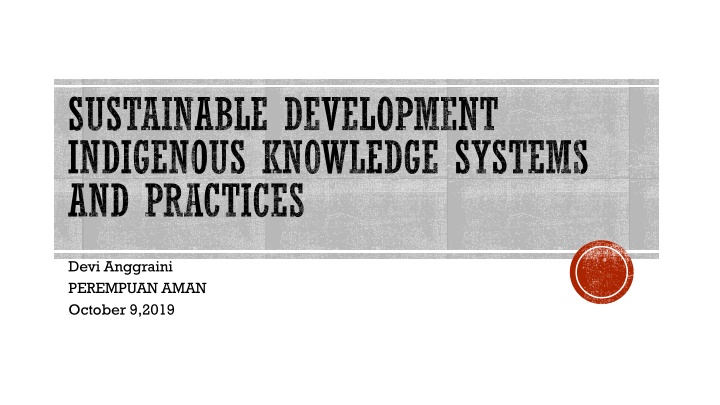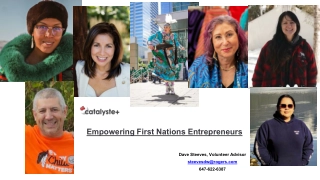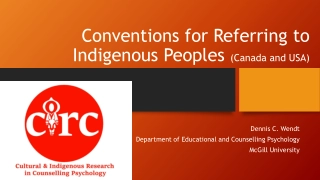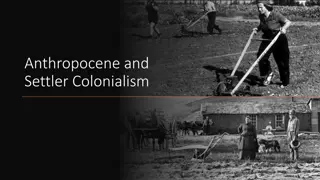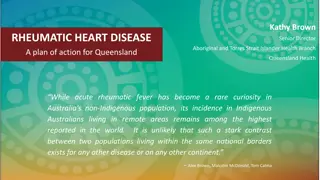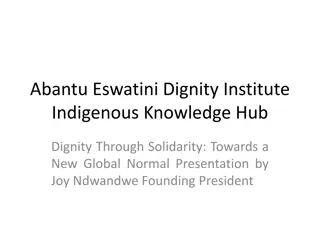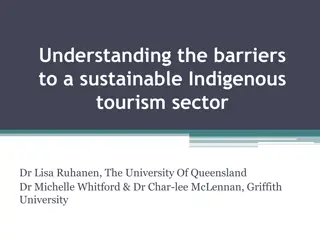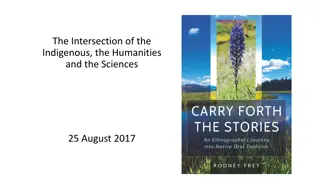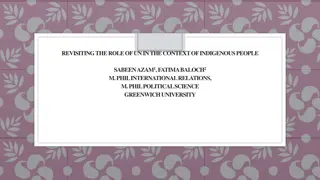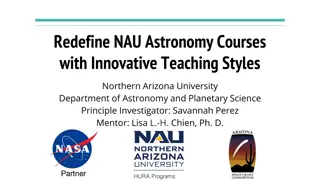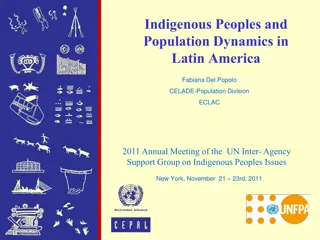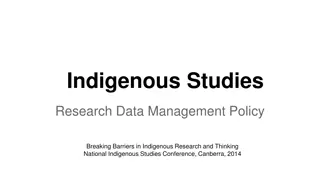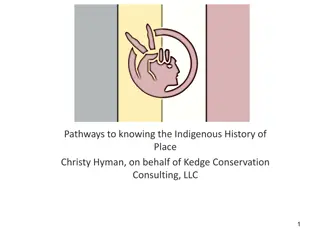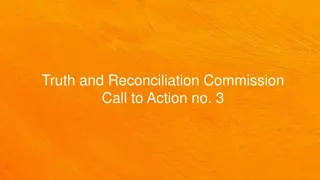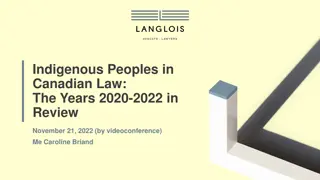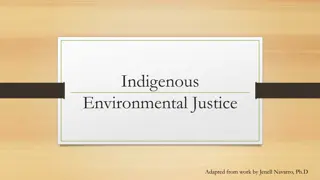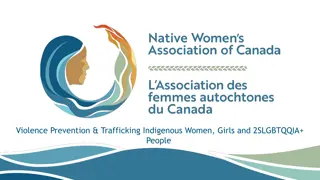Sustainable Development and Indigenous Knowledge Systems
Indigenous knowledge plays a crucial role in achieving sustainable development goals by promoting recognition and protection of rights, holistic approaches to development, participation in SDG processes, and the need for data disaggregation to capture the specific conditions of indigenous peoples. Engagement of indigenous peoples in SDGs is essential to ensure inclusivity and progress towards leaving no one behind.
Download Presentation

Please find below an Image/Link to download the presentation.
The content on the website is provided AS IS for your information and personal use only. It may not be sold, licensed, or shared on other websites without obtaining consent from the author.If you encounter any issues during the download, it is possible that the publisher has removed the file from their server.
You are allowed to download the files provided on this website for personal or commercial use, subject to the condition that they are used lawfully. All files are the property of their respective owners.
The content on the website is provided AS IS for your information and personal use only. It may not be sold, licensed, or shared on other websites without obtaining consent from the author.
E N D
Presentation Transcript
SUSTAINABLE DEVELOPMENT INDIGENOUS KNOWLEDGE SYSTEMS AND PRACTICES Devi Anggraini PEREMPUAN AMAN October 9,2019
GENERAL FEATURES OF THE 2030 AGENDA FOR SUSTAINABLE DEVELOPMENT The 17 Sustainable Development Goals (SDGs) with 169 related targets The Means of Implementation (MoI), which are the resources and partnerships necessary to reach the goals and targets; The Follow-Up and Review (FUR) processes and mechanisms that will monitor and guide the implementation: National, regional and global ( High level Political Forum ( HLPF) The 230 global indicators that will be used to measure progress. VOLUNTARY IN NATURE - Each government can set their priorities in relation to the Goals and Targets
ENGAGEMENT OF INDIGENOUS PEOPLES IN THE SDGS MAIN OBJECTIVES: 1. Promote the recognition and protection of the individual and collective rights of indigenous peoples including indigenous women, youth and PwD, elderly as affirmed by the UNDRIP: Right to Land territories and resources, right to self determination including self determined development and the implementation of the Free Prior and informed Consent, right to cultural integrity and heritage, 2. Promote the holistic approach of indigenous peoples to development that cares for peoples and nature, including the sustainable practices of indigenous peoples to resource management, food security, health and wellbeing as their invaluable contributions to sustainable development: Indigenous peoples as development actors and rights holders, not just vulnerable or marginalized group 3. Development of special measures to protect the specific rights and address the specific condition, needs and priorities of indigenous women, youth, persons with disabilities, elderly and children 4. Ensure the effective participation and inclusion of indigenous peoples in the SDG processes from local-national-regional and global levels in the context of leaving no one behind to include indigenous women, youth, persons with disabilities
INDICATORS AND DATA The UN Statistical Commission has adopted 230 global indicators to monitor the SDGs. National Statistical Offices (NSOs) are supposed to collect data based on these indicators. Indigenous peoples are often invisible in official statistics and thereby their specific condition are not captured: ie more poverty, less education than others Data disaggregation should be disaggregated where relevant, according to sex, age, race, ethnicity, migratory status, disability and geographical location . *** NEED to generate our own data to to demonstrate progress/ gaps and challenges in the implementation of the SDGs -- use of indigenous navigator- data generated by indigenous peoples in monitoring human rights , SDGs and the WCIP Outcome Document ( www.indigenousnavigator.org)
FOLLOW-UP AND REVIEW (FUR) Mechanisms to measure and guide progress in implementing the Goals and Targets. National level: States shall develop national action plans to implement the 2030 Agenda, and conduct regular and inclusive reviews of progress with contribution of stakeholders, including indigenous peoples Regional level: will be based on national-level reviews and contribute to the review at global level. Focus will be on identifying regional trends and addressing specific regional challenges including trans-boundary issues. UN Asia Pacific Forum on Sustainable Development under the UN- ESCAP (Economic and Social Commission for Asia-Pacific) Global level: annual High Level Political Forum (HLPF) - States to report on progress and challenges in reaching the Goals in their particular countries- )- Voluntary National Reviews (VNRs) ** 2030 agenda calls for the inclusion of indigenous peoples in the Follow Up and Review
SDGS AND INDIGENOUS PEOPLES: RISKS Non implementation of the principles: more rhetoric than implementation and transformation actions of leaving no one behind , realization of human rights inclusive balanced implementation of social, economic and environment dimensions; reducing inequality, etc Lack actions to address structural barriers such as patriarchy, unjust economic and political systems, lack of states accountability, systemic discrimination etc resulting to massive violation of IP rights ( land and resource grabs) in the name of sustainable development green growth TOP DOWN planning and implementation: exclusion of rights-holders Business as usual approach by states and corporations/private sector Public- Private Partnership without accountability more inequality, social injustice, corruption, ethnocide and violence and discrimination of Indigenous Women Voluntary nature of SDG implementation : States can select their priorities more focus on economic growth over social and environment concerns;
OPPORTUNITIES Mainstream the sustainable development practices, holistic approach and vision of indigenous peoples highlighting the roles and contributions of Indigenous Women; the critical contribution of traditional knowledge, sustainable resource management and governance. Human rights framework for sustainable development mainstream UNDRIP in the SDGS, women s rights, non-discrimination, dignity of IW Pledge of leaving no one behind inclusion of indigenous peoples specific needs and priorities, aspirations and protection of their individual and collective rights including women and persons with disabilities Pledge for balance implementation of the economic, social and environmental dimensions- demand respect for IP rights, FPIC and measures for environment protection Data dis-aggregation by ethnicity, participatory monitoring making indigenous peoples visible including specific condition of IW and IPwD
GAPS IN SDG IMPLEMENTATION: 4 YEARS OF IMPLEMENTATION No country is on track to meeting the goal of gender equality without which none of the others will be met, and in fact, the gap in several [of them] is growing. UN Sec Gen IMPLEMENTATION OF OF GOALS ARE LAGGING BEHIND: WE ARE NOT ON TRACT: UNDESA UNSG CALLED FOR A DECADE OF ACTION TO IMPLEMENT THE SDGS AND TO HAVE AN ANNUAL SUMMIT ON SDGS BY THE UNGA HUMAN RIGHTS RECOGNITION AND PROTECTION ( IPS, WOMEN, PWD ETC) NOT INTEGRATED AS FRAMEWORK OF SDG STRATEGIES AND ACTION PLANS : LACK OF INTEGRATION AND COHESION TO HUMAN RIGHTS OBLIGATIONS OF STATES ie IMPLEMENTATION OF UNDRIP RECOMMENDATIONS OF CEDAW COMMITTEE , UPR AND CERD COMMITTE RECOMMENDATIONS, ETC: MASSIVE HUMAN RIGHTS VIOLATIONS AND CRIMININALIZATION OF IPS IS WORSENNING LACK of MEANINGFUL PARTICIPATION AND INCLUSION OF INDIGENOUS PEOPLES AT ALL LEVELS : Indigenous Peoples including indigenous women remain largely invisible in national strategies/action plans
GAPS IN SDG IMPLEMENTATION: 4 YEARS OF IMPLEMENTATION ECONOMIC GROWTH UNDER BUSINESS AS USUAL APPROACH NOT TRANSFORMATIONAL TO CLOSE GAP OF INEQUALITY, SOCIAL JUSTICE SOCIAL AND ENVIRONMENTAL DIMENSIONS ARE NOT FULLY ACCOUNTED-- ALL TALK NO ACTION LACK OF COMMITMENT-- RESOURCES AND MECHANISMS FOR DATA DISAGGREGATION BY ETHNICITY and GENDER to measure progress and gaps for indigenous peoples; indigenous women LACK OF RECOGNITION AND SUPPORT TO IP ROLES, CONTRIBUTIONS and INITIATIVES TO SUSTAINABLE DEVELOPMENT PARTICULARLY IP WOMEN TRADITIONAL KNOWLEDGE, FOOD SYSTEMS, SUSTAINABLE RESOURCE MANAGEMENT ETC LACK OF SPECIAL MEASURES AND TARGETED PLANS TO REACH THOSE FURTHEST BEHIND FIRST ( ie INDIGENOUS PEOPLES -WOMEN, PWD ) GOAL 16 ON PEACE AND STRONG INSTITUTIONS IS NOT GIVEN MUCH ATTENTION ( GOOD GOVERNANCE, ACCOUNTABILITY, NON-DISCRIMINATION, ACCESS TO JUSTICE) : Massive human right violations land grabs, destruction of resources criminalization, political killings, violence and conflicts, dis-empowerment of women
